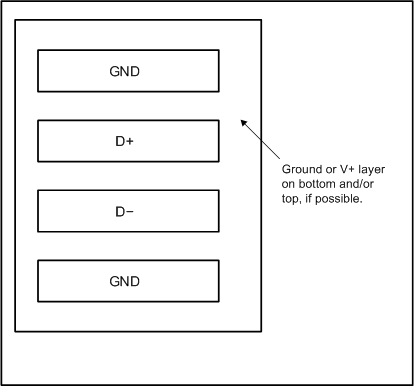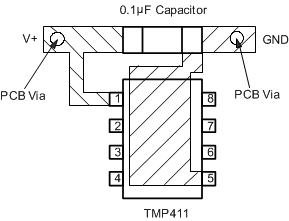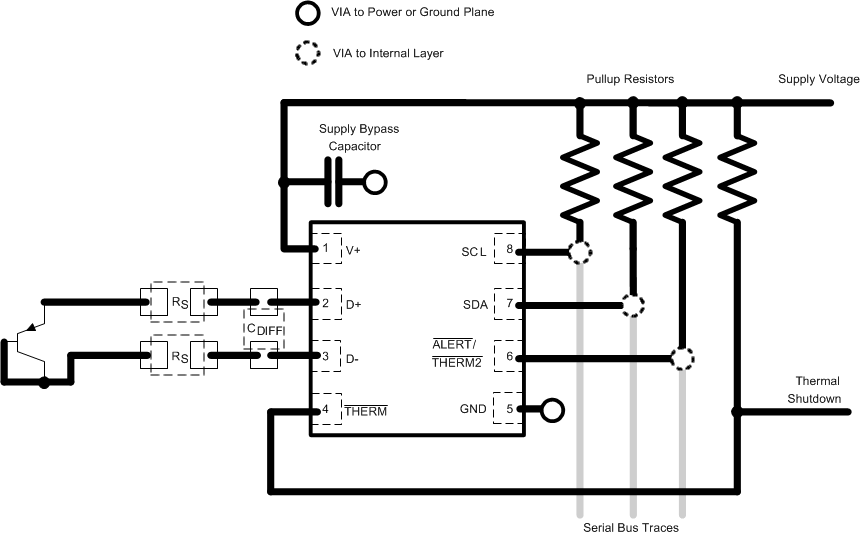SBOS383D December 2006 – December 2016 TMP411
PRODUCTION DATA.
- 1 Features
- 2 Applications
- 3 Description
- 4 Revision History
- 5 Device Comparison Table
- 6 Pin Configuration and Functions
- 7 Specifications
- 8 Typical Characteristics
-
9 Detailed Description
- 9.1 Overview
- 9.2 Functional Block Diagram
- 9.3 Feature Description
- 9.4 Device Functional Modes
- 9.5 Programming
- 9.6
Register Map
- 9.6.1 Register Information
- 9.6.2 Pointer Register
- 9.6.3 Temperature Registers
- 9.6.4 Limit Registers
- 9.6.5 Status Register
- 9.6.6 Configuration Register
- 9.6.7 Resolution Register
- 9.6.8 Conversion Rate Register
- 9.6.9 N-Factor Correction Register
- 9.6.10 Minimum and Maximum Registers
- 9.6.11 Consecutive Alert Register
- 9.6.12 THERM Hysteresis Register
- 9.6.13 Remote Temperature Offset Register
- 9.6.14 Identification Registers
- 10Application and Implementation
- 11Power Supply Recommendations
- 12Layout
- 13Device and Documentation Support
- 14Mechanical, Packaging, and Orderable Information
Package Options
Mechanical Data (Package|Pins)
Thermal pad, mechanical data (Package|Pins)
- DGK|8
Orderable Information
12 Layout
12.1 Layout Guidelines
Remote temperature sensing on the TMP411 measures small voltages using low currents, and therefore noise at the device inputs must be minimized. Most applications using the TMP411 have high digital content with several clocks and logic-level transitions that create a noisy environment. The layout must adhere to the following guidelines:
- Place the TMP411 as close to the remote junction sensor as possible.
- Route the D+ and D– traces next to each other and shield the traces from adjacent signals using ground guard traces, as shown in Figure 21. If a multilayer PCB is used, bury these traces between ground or VDD planes to shield them from extrinsic noise sources. TI recommends using 5-mm (0.127 mm) PCB traces.
- Minimize additional thermocouple junctions caused by copper-to-solder connections. If these junctions are used, make the same number and approximate location of copper-to-solder connections in the D+ and D– connections to cancel any thermocouple effects.
- Use a 0.1–µF local bypass capacitor directly between the V+ and GND pins of the TMP411, as shown in Figure 22. Minimize filter capacitance between D+ and D– to 1000 pF or less for optimum measurement performance. This capacitance includes any cable capacitance between the remote temperature sensor and the TMP411 .
- If the connection between the remote temperature sensor and the TMP411 is less than eight inches (20 cm), use a twisted-wire pair connection. If the connection measures more than eight inches (20 cm), use a twisted, shielded pair with the shield grounded as close to the TMP411 as possible. Leave the remote sensor connection end of the shield wire open to avoid grounded loops and 60-Hz pickup.
 Figure 21. Example Signal Traces
Figure 21. Example Signal Traces
 Figure 22. Suggested Bypass Capacitor Placement
Figure 22. Suggested Bypass Capacitor Placement
12.2 Layout Example
 Figure 23. TMP411 Device Layout
Figure 23. TMP411 Device Layout